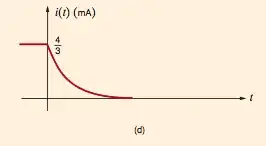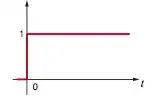The following is a graph of the current across some circuit element:

Note how the current is treated like a smooth continuous function. Even in the analysis of things (i.e. analysis of the transient state of an RC circuit) current is treated like a continuous smooth function.
This is how currents works:
Say you have a voltage source connected to some wire which is then connected to some component. A field will be established in the wire, and electrons will move around for say $t$ seconds, creating surface charge to ensure the field is uniform and points in the correct direction. The period during which surface charge moves around to establish the field is known as the transient state. For a more detailed explanation, see: https://physics.stackexchange.com/a/102936/28118
This transient state lasts for a very short time - a couple of nanoseconds, but exists none the less. So there is a short time between when the voltage source is connected and a current is established.
Now say the voltage source is non-constant. Say it starts of at a voltage V when you connect it to a circuit. The transient state will exist for a couple of nanoseconds and then current will be established. Now say you increase the voltage. The transient state will happen again and then a new current will be established.
My point is that the current doesn't change "smoothly". Rather, it's a bunch of discrete points, with the space between the points being the transient state and therefore having an undefined current.
Q1) So why is it valid to treat current like a continuous function instead of the discrete function that it is?
Q2) Say you have a current pulse function:

In real life, would the function really be a pulse or would it really be an extremely steep line (but a slope of non-infinity none the less)? I would expect the slope to be non-infinity since it would take a couple of nanoseconds to establish the current instead of it being immediate as the function suggests.